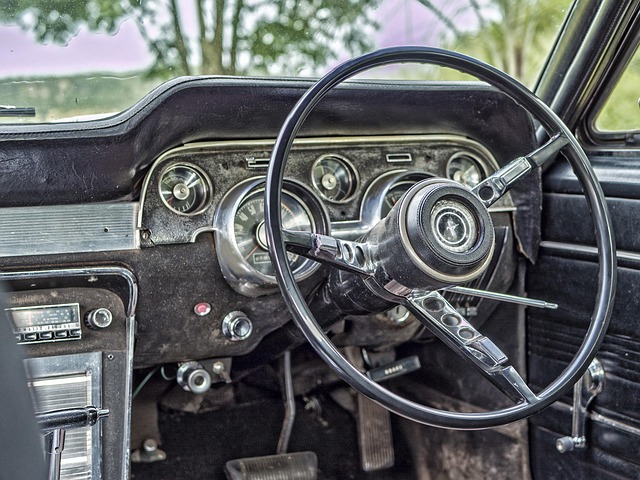Looking to register your car in California? This comprehensive guide walks you through every step, from understanding eligibility requirements to securing a dmv vin verifier. We break down the necessary documents, vehicle inspection, title transfer, and the final registration process at the DMV. By following these clear instructions, you’ll have your California vehicle registered smoothly and efficiently.
- Understand Eligibility Requirements for Car Registration
- Gather Necessary Documents for California DMV
- Prepare Vehicle Inspection and Title Transfer
- Visit DMV for Registration and VIN Verification
- Complete Post-Registration Steps and Plate Placement
Understand Eligibility Requirements for Car Registration

Before you start the registration process, it’s crucial to understand if your car meets California’s eligibility requirements. To register a vehicle in California, the car must be legally imported and meet certain safety standards set by the Department of Motor Vehicles (DMV). Additionally, the vehicle needs to have a valid and accurate Vehicle Identification Number (VIN) verified using a reliable method like a DMV VIN verifier or a mobile VIN verifier for inspections. Ensure your car’s title is also ready, as it’s an essential document in the registration process.
Furthermore, certain types of vehicles may require additional documents or inspections, such as those that are custom-built, imported from outside the US, or have undergone significant modifications. It’s important to check with a local DMV branch or use their online resources for specific guidelines, especially if you’re dealing with a unique vehicle. A mobile VIN inspection can also be beneficial in ensuring all paperwork is in order before heading to the DMV.
Gather Necessary Documents for California DMV

Before you can register your car with the California Department of Motor Vehicles (DMV), you’ll need to gather several key documents and complete a vehicle identification number (VIN) inspection. This process ensures that your vehicle meets all legal standards before it’s allowed on California’s roads. Start by collecting your vehicle’s registration papers from its previous state, as well as proof of ownership, such as a title document. Additionally, you’ll need to provide a current insurance card and a valid driver’s license or identification card.
For a seamless experience, consider using a mobile vin verification service that can conduct the necessary vin inspection remotely. These services employ advanced technology to cross-reference your vehicle’s VIN with state records, streamlining the process significantly. This approach not only saves you time but also makes it easier to resolve any potential issues early in the registration process.
Prepare Vehicle Inspection and Title Transfer

Before you can register your car in California, you’ll need to ensure that your vehicle passes an inspection. This process involves verifying that your car meets the state’s safety and emission standards. Start by scheduling a mobile vin inspection if you prefer convenience; many services offer this option, allowing a trained professional to come to your location. Alternatively, visit a California Department of Motor Vehicles (DMV) office for a traditional vin inspection. During this check, they’ll assess critical components like brakes, lights, and emissions controls using the Vehicle Identification Number (VIN), which can be found on the vehicle’s registration or title document.
Once your car has passed the inspection, you’ll need to transfer the title from the previous owner. This involves obtaining a signed bill of sale and ensuring that the seller provides a clear title. You can then use these documents, along with your completed application form and necessary fees, to complete the registration process at a DMV office. Remember, having accurate and up-to-date information is key, including the correct VIN which a DMV vin verifier can assist in locating if needed.
Visit DMV for Registration and VIN Verification

To begin the process of registering your car in California, one of the first steps is to visit a DMV (Department of Motor Vehicles) office or use their online services for registration and VIN verification. The DMV plays a crucial role in ensuring all vehicles on California roads meet safety standards and are properly documented. During this process, you’ll need to present several documents, including proof of ownership, insurance, and identification.
A significant part of the registration involves verifying the Vehicle Identification Number (VIN). This unique code is essential for identifying your car and can be checked through a DMV vin verifier. You can opt for traditional VIN inspection at a designated DMV location or even use mobile vin verification services that come to you, making the process more convenient.
Complete Post-Registration Steps and Plate Placement

After successfully registering your car with the California DMV (Department of Motor Vehicles), there are a few crucial post-registration steps to complete. One of the most important is ensuring proper vehicle identification number (VIN) verification. This process involves using a reliable tool like a DMV VIN verifier or even a mobile vin inspection app for accurate and immediate results. The state requires this step to guarantee that your car’s details match those on record, enhancing road safety by deterring fraud and theft.
Proper placement of vehicle registration plates is another vital task. After acquiring your plates, mount them securely on your vehicle as specified by California law. This typically involves attaching the license plate to the rear of your car, ensuring it’s clearly visible from all angles. Remember, proper plate placement not only complies with legal requirements but also aids in quick identification during traffic stops or other official inspections using tools like a mobile VIN verifier.
Registering a car in California involves understanding eligibility requirements, gathering essential documents, preparing for vehicle inspections and title transfers, visiting the DMV for registration and VIN verification, and completing post-registration tasks. By following these steps diligently, you can ensure your vehicle’s compliance with state regulations, making roads safer and smoother for all Californians. Remember to keep your documentation up-to-date and consult a dmv vin verifier when needed to maintain your vehicle’s legal status.
